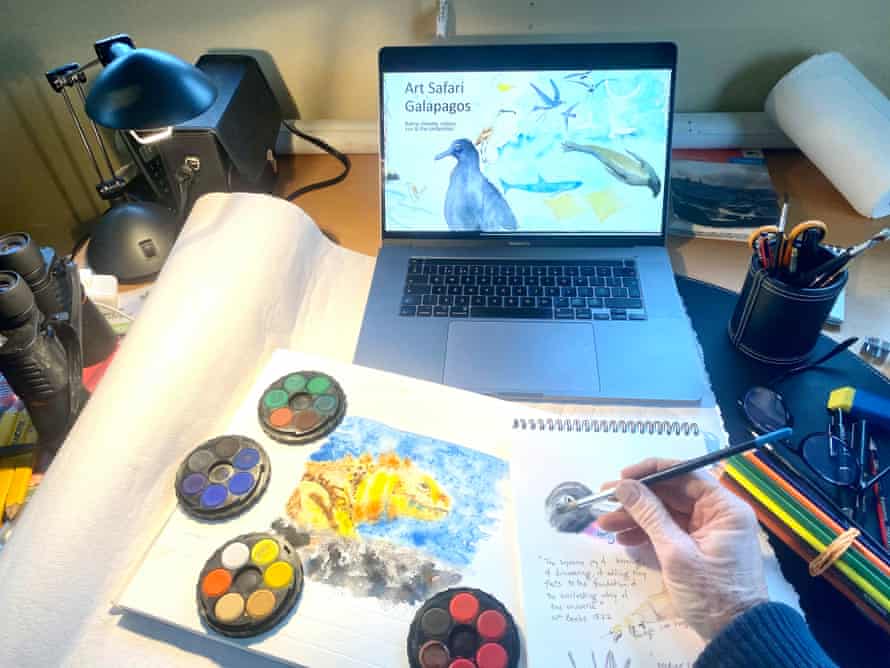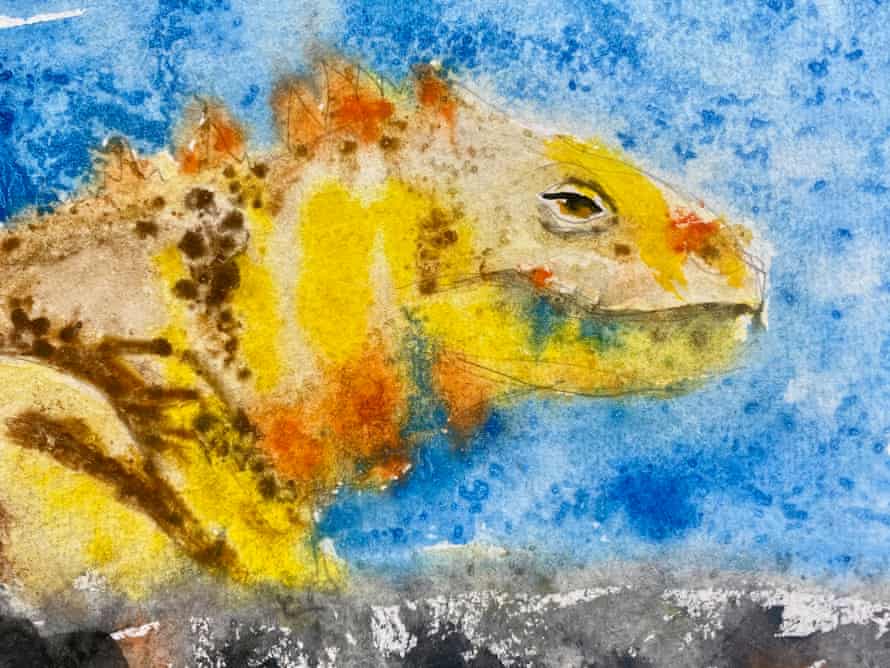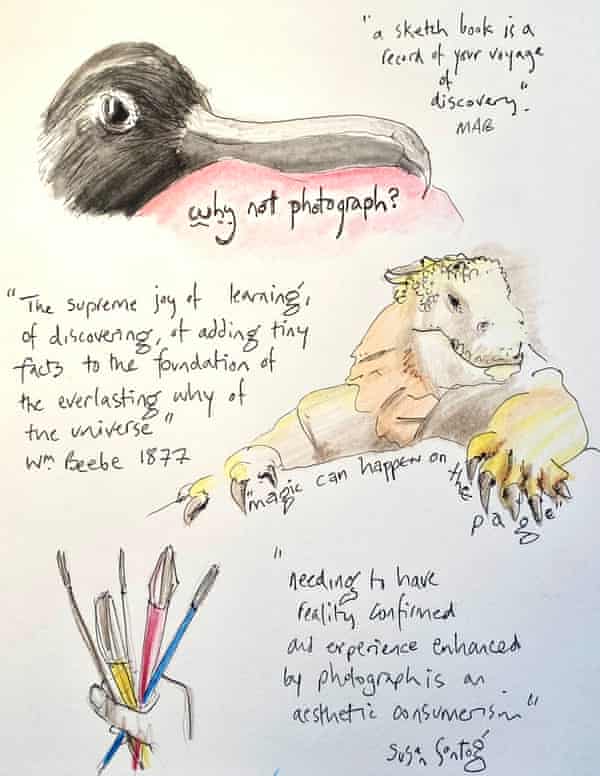The creature comes into view quite slowly. It’s like staring into the bushes, realising there is something there, then picking out its parts, assembling the whole that, suddenly, magically, comes alive and steps gently forward. A giant tortoise. Mary-Anne, our guide, laughs: “A tortoise’s mouth always remind me of my grandmother.” As if hearing this, the animal’s wrinkled lip curls slightly, into a sad old grin. The panels on its shell catch the light and the shadows under the leading edge deepen, catching subtle flashes of magenta and ultramarine. I would never have noticed such details without Mary-Anne pointing them out.
“There,” she says, “I think we’re finished.” And puts down her brush.
A trip to the Galápagos Islands would be a very fine thing in these times, wouldn’t it? And I am there, at least in spirit, visiting virtually on a four-day journey – on Zoom – with a group of artists led by Mary-Anne Bartlett, the founder of Art Safari, who has been to the archipelago several times. During the pandemic she has switched to offering virtual tours and workshops. But can such a visit give any satisfaction, anything like the pleasure of actually going? It is certainly a heck of lot cheaper, but would the relatively small fee be better saved up for an actual trip?
One immediate similarity to real travel is quickly self-evident. On day one I am sitting in front of my laptop with a motley collection of art equipment, feeling conspicuously like that person who lands in the tropics wearing a woolly jumper and thick socks. The watercolour paper I bought at the last minute on Amazon is half the size I thought it would be; the lead inside my pencils is broken; the paintbrushes are moulting. Not only that, there’s an incomprehensible foreign language to learn: gouache, gesso, brusho. Plus words that seem to have taken on new and precise meanings that I need to master. What is a flat wash? The opposite of a bumpy bath?

Mary-Anne soon dispels all these new-arrival problems and we are whisked – via the magic of PowerPoint – to Puerto Ayora on the island of Santa Cruz. Not having been to the Galápagos, I had mistakenly imagined them to be uninhabited, patrolled only by the ghosts of Victorian naturalists determined to preserve the sacred Temple of Evolution. Wrong. This is a bustling town filled with restaurants and shops and market stalls. Mary-Anne takes us to meet the women who run the fish market, each with an attendant sea lion who cleans up the discarded catch, or at least every morsel that the pelicans don’t snaffle. We wander down to the jetty and gawp in disbelief at the eagle rays and sharks cruising below our feet. The photographs are cleverly chosen: nothing too sleek or manicured, with no attempt to edit out the tourists with sketchpads and cameras. The understated effect is to place us there, in the frame.
Now we settle down for a bit of background, including the artists who came before: characters like Charles Darwin, William Beebe, and Conrad Martens. We get advice from Robert Fitzroy, Darwin’s captain on the Beagle: “Observe, study and collect.” And most importantly perhaps, we start to sense what happens when you don’t take photographs. Like us, Darwin could not, so he looked carefully and sketched endlessly. Even if I had gone on an art tour of the Galápagos, I know I would have been snapping away like a machine gun. The musical score of my journey would be the sound of a camera motor drive. Not this time. Could that be a blessing? Susan Sontag thought so: “Needing to have reality confirmed and experience enhanced by photographs is an aesthetic consumerism to which everyone is now addicted. Industrial societies turn their citizens into image-junkies; it is the most irresistible form of mental pollution.” And she wrote that almost 20 years before the smartphone.

We are not being quite so purist. Photographs are necessary to our goal. Mary-Anne announces that it is time to start work and a series of wildlife pictures flash up: frigate birds, albatrosses and iguanas. We get two minutes each, starting with pencil, but then switching to the brush and trying to draw with paint. The significance is immediate: I find I know within 30 seconds whether I’ve caught a true line, or the piece is binwards bound. And I’m looking intensely. “Try it without even looking at your work,” suggests another participant. Some of the group are professional artists, which will prove very useful, but others are, like me, beginners, which is reassuring.

After a tea break, we sit back and watch Mary-Anne draw boobies – the blue-footed variety. Then we have a go. In the evening there is a live webcam session with sea lions. The benefits of the two-minute sketching discipline are very apparent. Next day the time limit is halved to a minute, then to 30 seconds. Frigate birds become a few flicks of the brush, and sometimes, in a rare moment of epiphany, one of those flicks captures the creature. Is this what the cave artists felt 44,000 years ago when they conjured wild pigs out of red clay on a wall of stone? A lot of our time is spent looking at each other’s work, peering over virtual shoulders and discussing. Then we watch Mary-Anne execute an entire painting, picking up valuable tidbits of advice throughout.
On the fourth day we are sketching tortoises and birds in under 15 seconds. “Keep doing it,” Mary-Anne tell us, “and slowly your ability to hold the image of what you’re seeing in your mind’s eye will extend.” I’m beginning to realise how much more ambitious than any earthbound journey this is. We are reorganising our perceptions, our brain architecture. We have jettisoned our hunger to take photographs and instead are looking more deeply.
When we are finished, I realise that I am not dying to get out to the Galápagos; what I want is to settle down in front of the bird-feeder outside the kitchen window and try to paint the greater spotted woodpecker which has started visiting. Lockdown has forced this unusual journey on me, but it has proved to be one I am very glad to have taken.
• Art Safari runs regular virtual art trips – upcoming ones include Namibia (28-31 Jan, £140) – and art tutorials such as Wake up your Watercolours (27 Jan, free)





